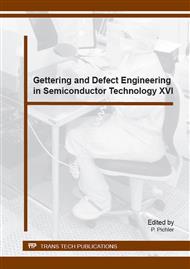p.427
p.434
p.440
p.449
p.459
p.466
p.472
p.478
p.484
Comparative Investigations of the Surface Damage of Monocrystalline Silicon Wafers by Scanning Infrared Reflection Examination and Raman Spectroscopy
Abstract:
Mechanical preparation of mono-and multicrystalline silicon wafers by sawing, lapping, or grinding damages the surface. Depending on the mechanical impact of the treatment different degrees of damage structures occur. It is necessary for further processing of wafers to have damage free and contactless methods to characterize structures such as changes of the lattice structure by phase transformations or plastic deformations, and microcracks below the surface. In this paper we present results of investigations on the sub-surface damage by two contactless optical methods: Scanning infrared reflection polarimetry with SIREX and Raman spectroscopy. The investigations were carried out on silicon wafers sawn with the multi-wire technique using diamond coated wires. The sub-surface damage mainly consists of microcracks of different length, which penetrate several micrometers into the bulk. The results were compared with confocal microscopy and scanning electron microscopy analyses of the same damage structures.
Info:
Periodical:
Pages:
466-471
Citation:
Online since:
October 2015
Price:
Сopyright:
© 2016 Trans Tech Publications Ltd. All Rights Reserved
Share:
Citation:


